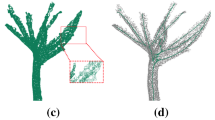Abstract
This paper presents a simple yet powerful rotational-guided optimal cutting-plane extraction method which can provide an effective way for skeleton extraction, simplification, surface reconstruction and boundary extraction. The optimal cutting-planes can be obtained by several steps: calculating the cutting-points and initial cutting-plane, rotating reference cutting-plane on each cutting-point along the given rotation axis to generate a group of cutting-planes, calculating the area of these planes and selecting the plane with the smallest projected area. The primary advantage of the proposed method is that it does neither place strong requirements on the quality of input point cloud nor on the geometry of captured shapes. The experimental results demonstrate that our method can extract the optimal cutting-planes effectively for an unoriented raw point cloud model, even in the presence of noise and missing data.


























Similar content being viewed by others
References
Huang KW, Tang J, Gang-Shan WU (2006) Skeleton extraction algorithm using reeb graph based on facets. J Syst Simul 18(1):52–56
Xiao W, Deng M, Li C (2014) A surface reconstruction algorithm based on 3d point cloud stratified sliced. Sens Trans 173(6):197–203
Yang Z, Yong Y (2014) Boundary extraction based on point cloud slices. Comp Appl Soft 31(1):222–224
Nepal A, Gurumoorthy B (2016) A slice based approach to recognize and extract free-form volumetric features in a CAD mesh model. Comp Aided Des Appl 13(5):587–599
Guan Y, Zhao X, Wang P (2016) Dapeng Li. Parallel algorithm for massive point cloud simplification based on slicing principle. J Comp Appl 36(7):1793–1796
Zhang S, Zhang H, Fang X, Li F (2009) Research on data pre-processing with point cloud slicing technique. J Jiangsu Univ Sci Technol 23(5):403–406
Park HT, Chang MH, Park SC (2007) A slicing algorithm of point cloud for rapid prototyping. Summer Computer Simulation Conference, SCSC 2007, San Diego, CA, USA, July. DBLP, p 24
Oropallo W, Piegl LA, Rosen P, Rajab K (2017) Point cloud slicing for 3-D printing. Comp Aided Des Appl 4:1–8
Zeng L, Lai LM, Qi D, Lai YH, Yuen MF (2011) Efficient slicing procedure based on adaptive layer depth normal image. Comput Aided Des 43:1577–1586
Li M, Lu Z, Huang L (2010) An approach to 3d shape blending using point cloud slicing. IEEE Int Conf Comp Aided Des:919–922
Sareen KK, Knopf GK, Canas R (2010) Surface reconstruction from sliced point cloud data for designing facial prosthesis. Sci Technol Hum:6–11
Wu YF, Wong YS, Loh HT, Zhang YF (2004) Modeling cloud data using an adaptive slicing approach. Comput Aided Des 36(3):231–240
Wang Y, Wang L, Hao W, Ning X (2018) A novel slicing-based regularization method for raw laser point clouds in visible IoT. IEEE Access 6(1):18299–18309
Zhang YF, Wong YS, Loh HT, Wu YF (2003) An adaptive slicing approach to modeling cloud data for rapid prototyping. J Mater Process Technol 140(1–3):105–109
Javidrad F, Pourmoayed AR (2011) Contour curve reconstruction from cloud data for rapid prototyping. Robot Comput Integr Manuf 27(2):397–404
Zhong S, Yang Y, Huang Y (2014) Data slicing processing method for re/rp system based on spatial point cloud data. Comp Aided Des Appl 11(1):20–31
Sui W, Wang LF, Fan B, Xiao HF, Wu HY, Pan CH (2016) Layer-wise floor plan extraction for automatic urban building reconstruction. IEEE Trans Vis Comput Graph 22(3):1261–1277
Wang Y, Zhang H, Zhao Y, Hao W, Ning X, Shi Z, Zhao M (2015) Three-dimensional reconstruction method of Tang dynasty building based on point clouds. Opt Eng 54(12):123111–123111
Kulkarni P, Dutta D (1996) An accurate slicing procedure for layered manufacturing. Comput Aided Des 28(9):683–697
Nagai Y, Ohtake Y, Suzuki H (2015) Tomographic surface reconstruction from point cloud. Comput Graph 46:55–63
Liu GH, Wong YS, Zhang YF, Loh HT (2003) Modeling cloud data for prototype manufacturing. J Mater Process Technol 138(1–3):53–57
Tagliasacchi A, Zhang H, Cohen-Or D (2009) Curve skeleton extraction from incomplete point cloud, ACM transactions on graphics (TOG). ACM 28(3):1–9
Liu H, Zhang D (2011) Fast 3D point cloud ear identification by slice curve matching. Int Conf Comp Res Dev 4:224–228
Wang G, Cheng J, Li R, Cohen-Or D (2015) A new point cloud slicing based path planning algorithm for robotic spray painting. IEEE Int Conf Robot Biom:1717–1722
Ding D, Pan Z, Cuiuri D, Li H, Larkin N, Duin S (2016) Automatic multi-direction slicing algorithms for wire based additive manufacturing. Robot Comput Integr Manuf 37(C):139–150
Fang F, Cheng XJ (2013) A fast data reduction method for massive scattered point clouds based on slicing. Geom Info Sci Wuhan Univ 11(38):1353–1357
Gottschalk S, Lin MC, Manocha D (1996) OBBTree: a hierarchical structure for rapid interference detection. Conference on Computer Graphics and Interactive Techniques. ACM, pp 171–180
Timmerman ME (2003) Principal component analysis (2nd ed.) by I. T. Jolliffe. J Am Stat Assoc 98(1):1082–1083
Lin H, Chen W, Wang G (2005) Curve reconstruction based on an interval B-spline curve. Vis Comput 21(6):418–427
Stanford 3D Scanning Repository, AIMSHAPE Shape Repository. Accessed Jan 2011. [Online]. Available: http://www.aimatshape.net.
Huang H, Wu S, Cohen-O D, Gong M, Zhang H, Chen B (2013) L1-medial skeleton of point cloud. ACM Trans Graph 32(4):1–8
Acknowledgments
This work is supported in part by National Key R&D Program of China under Grant No. 2018YFB1004905; in part by National Natural Science Foundation of China under Grant No.61872291, No.61902302, No.61871320; in part by Shaanxi Natural Science Foundation under Grant No. 2017JQ6023; in part by Scientific Research Program Funded by Shaanxi Provincial Education Department under Grant No. 18JS077. We would like to thank the author (Huang H [31]) to share their scanned models in this paper.
Author information
Authors and Affiliations
Corresponding author
Additional information
Publisher’s note
Springer Nature remains neutral with regard to jurisdictional claims in published maps and institutional affiliations.
Rights and permissions
About this article
Cite this article
Wang, Y., Zhang, H., Wang, N. et al. Rotational-guided optimal cutting-plane extraction from point cloud. Multimed Tools Appl 79, 7135–7157 (2020). https://doi.org/10.1007/s11042-019-08339-w
Received:
Revised:
Accepted:
Published:
Issue Date:
DOI: https://doi.org/10.1007/s11042-019-08339-w




